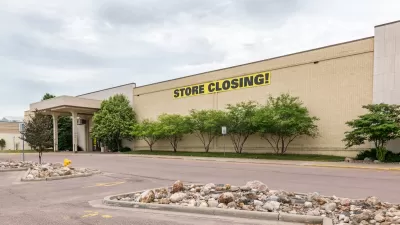Using Greenwood, Indiana as an example, Eric McAfee discusses how the value of individual suburban malls depreciates over time. Shiny new shopping centers compensate for inevitable vacancies in older ones.

Online shopping and changing consumer preferences have prompted speculation about the suburban mall's decline. Eric McAfee offers some perspective on the cycle of retail decline and rebirth. On malls, he writes, "History has proven time and again that, as soon as one new development opens its doors, another one within a five-mile radius begins a steady and generally incorrigible decline."
McAfee's piece looks closely at the spread of retail centers in Greenwood, including its long-neglected main street. "So why does Greenwood need a new shopping district more than half the size of the regional mall, which sits just two miles away?"
American retail has incredible staying power, but not in any one fixed location. "Americans respond more positively to shiny new things than they respond negatively to what gets left in the wake—the abandonment. Or else they catch abandonment amnesia when the next glossy package comes along. All a retail developer needs is 10-15 years of successful tenancy to reap solid profits—which is about all they can expect when depreciation life cycles are so brief."
FULL STORY: The Case in Greenwood: Why America Deserves Its Retail Blight.

Maui's Vacation Rental Debate Turns Ugly
Verbal attacks, misinformation campaigns and fistfights plague a high-stakes debate to convert thousands of vacation rentals into long-term housing.

Planetizen Federal Action Tracker
A weekly monitor of how Trump’s orders and actions are impacting planners and planning in America.

Chicago’s Ghost Rails
Just beneath the surface of the modern city lie the remnants of its expansive early 20th-century streetcar system.

Bend, Oregon Zoning Reforms Prioritize Small-Scale Housing
The city altered its zoning code to allow multi-family housing and eliminated parking mandates citywide.

Amtrak Cutting Jobs, Funding to High-Speed Rail
The agency plans to cut 10 percent of its workforce and has confirmed it will not fund new high-speed rail projects.

LA Denies Basic Services to Unhoused Residents
The city has repeatedly failed to respond to requests for trash pickup at encampment sites, and eliminated a program that provided mobile showers and toilets.
Urban Design for Planners 1: Software Tools
This six-course series explores essential urban design concepts using open source software and equips planners with the tools they need to participate fully in the urban design process.
Planning for Universal Design
Learn the tools for implementing Universal Design in planning regulations.
planning NEXT
Appalachian Highlands Housing Partners
Mpact (founded as Rail~Volution)
City of Camden Redevelopment Agency
City of Astoria
City of Portland
City of Laramie





























